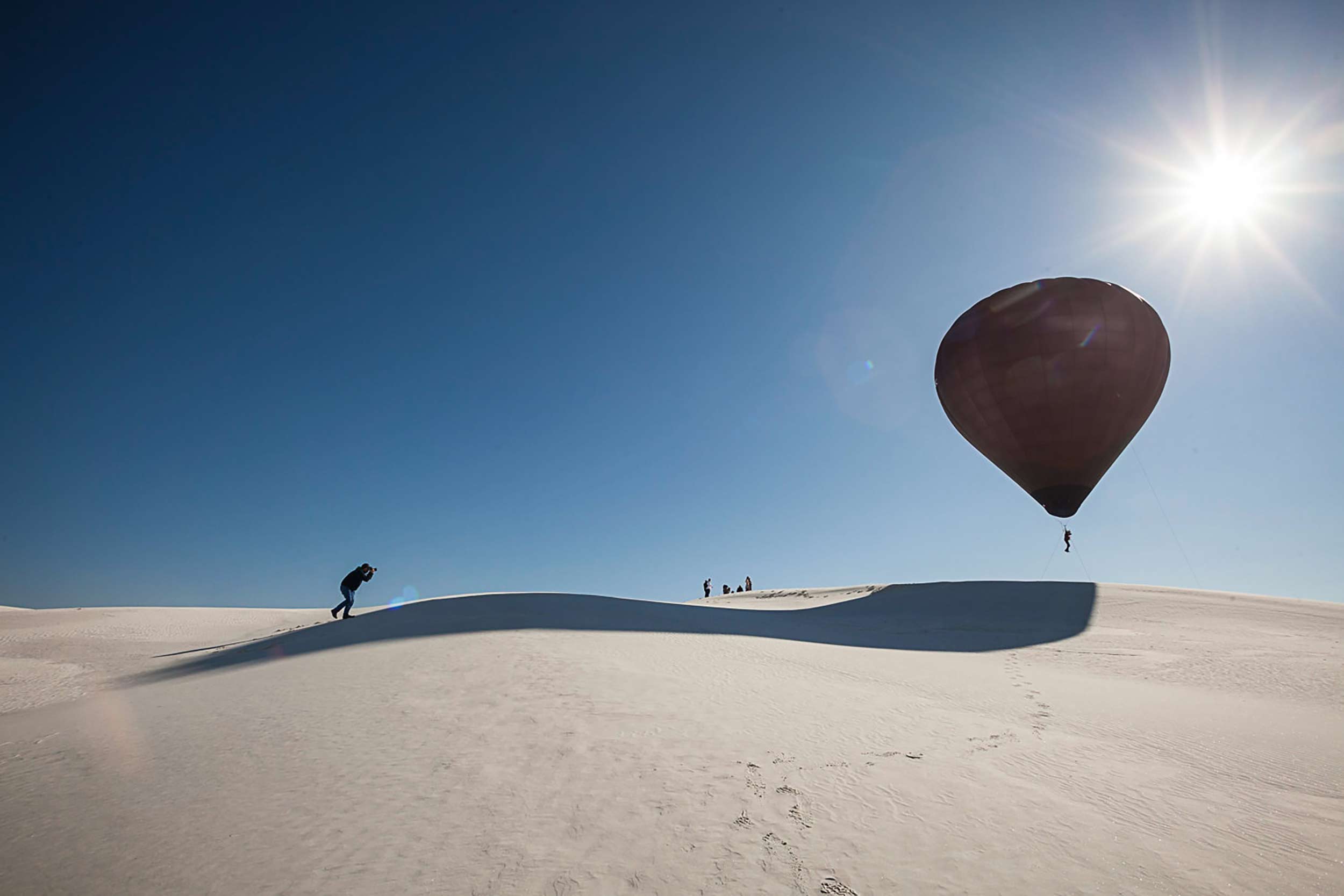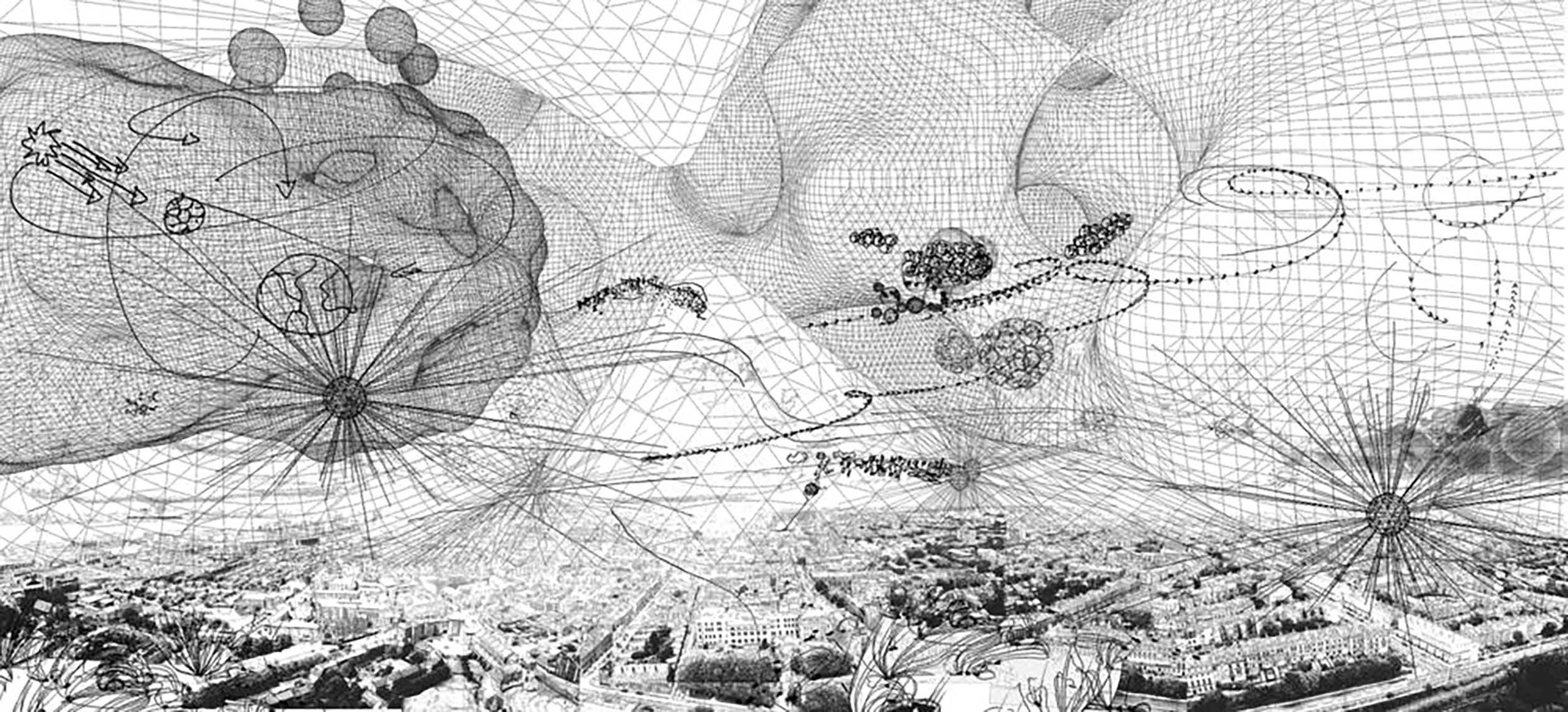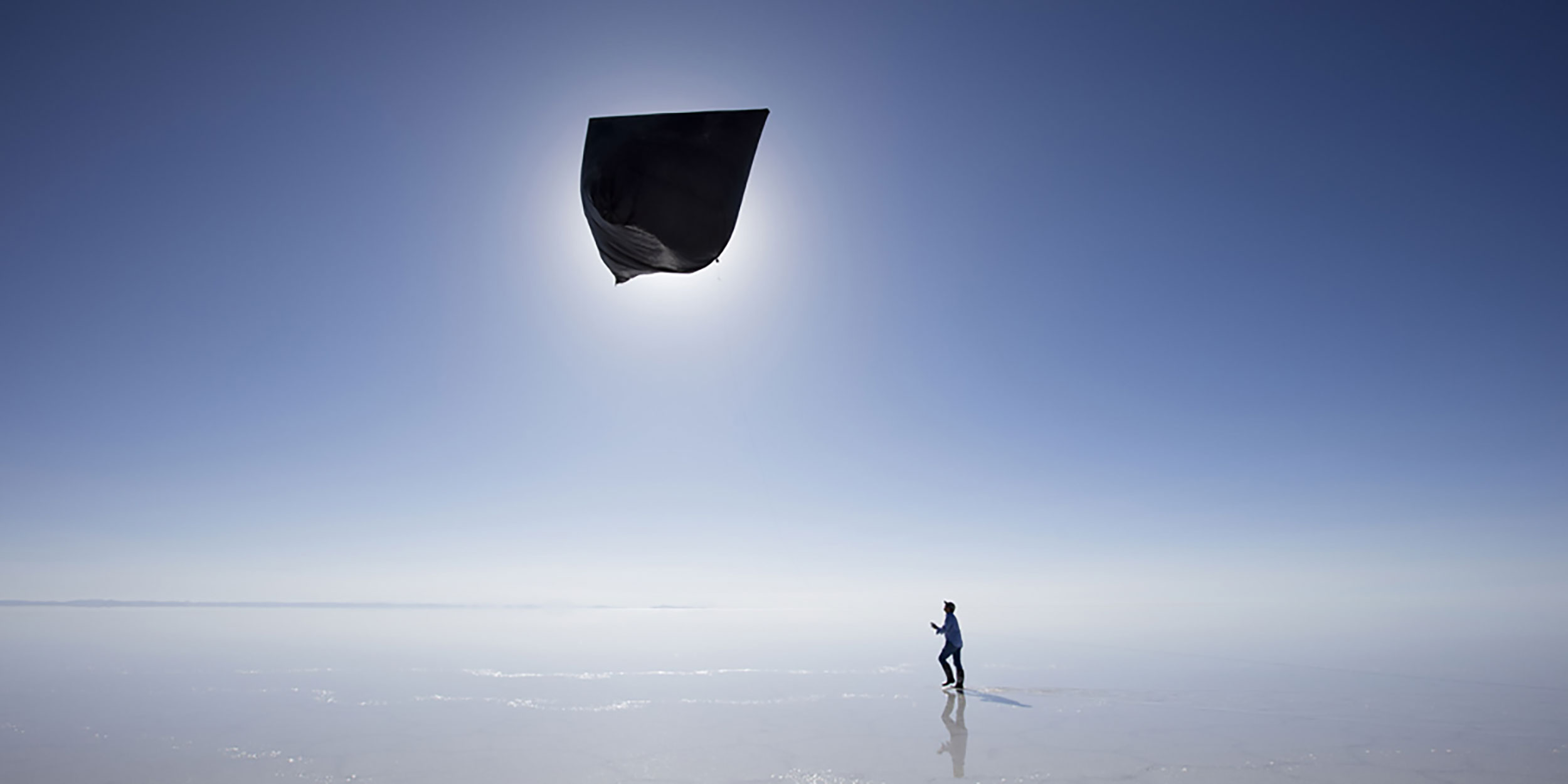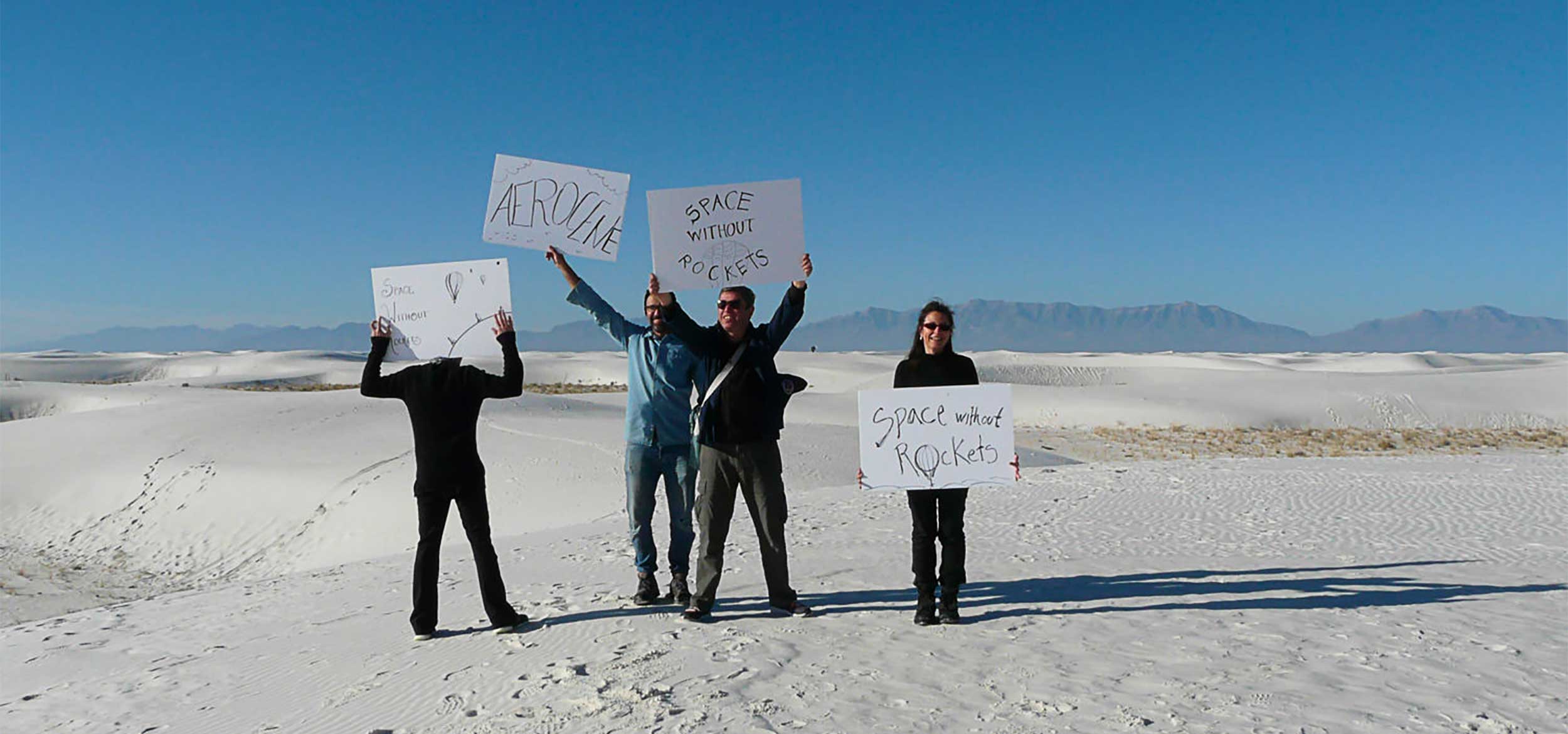SPACE WITHOUT ROCKETS: CULTURAL AND HUMAN FACTORS APPROACHES TO SUSTAINABLE SPACE TRAVEL
 SHARE THIS
SHARE THIS
It is now almost a year since the Argentine-born artist Tomás Saraceno launched the the first certified human flight in a zero-carbon solar-powered hot air balloon, the D-0AC air fuelled sculpture which floated for nearly three hours, becoming buoyant only by the heat of the sun and infrared radiation from the surface of the earth, at the White Sands National Monument in New Mexico in the USA.
Organised by Studio Saraceno, curator and author of this paper, Rob La Frenais and the Rubin Center at the University of Texas at El Paso (Director Kerry Doyle), the world record-breaking launch took place at dawn on November 8 2015 within the context of the exhibition ‘Space Without Rockets’ at the University. Since then a number of associated projects under the title ‘Aerocene’ have taken place, notably at the COP21 Climate Change conference and a series of unmanned solar launches in Germany.
The artist, Tomás Saraceno, said of the overall project: “Aerocene is an artistic project, an invitation to shape a period of time, a new epoch”, while visiting writer and former colleague of the curator and author, Nicola Triscott said: “Aerocene holds a message of simplicity, creativity and co-operation for a world of tumultuous geopolitical relations reminding us of our symbolic relationship with the earth and all its species”.
The Arts Catalyst had invited some artists to set some challenges, and Tomás’s vision of how we can live in space, now, was probably one of the greatest. The bewildering blur of images of floating cities and solar balloons in reflective deserts seemed anything but modest and achievable to the assorted space scientists and engineers, who were basically looking for a way to popularise the activities of the agency. Tomás had previously hit a number of engineering brick walls while attending the summer school of the International Space University. But he had not given up his dream of how we might approach deep space, inspired by John Powell, of floating there on balloons rather than blasting there on rockets.

Some context for the desire for sustainability in space travel should be given here. A recent NASA study in 2011 on the consequences of 1000 space flights per year (as opposed to 70-100 annual launches today) indicates that changes in climactic balance could cause polar surface temparatures to rise by 1 degree centigrade and reduce polar ice by 5-15%. There is also the issue of black carbon which once spread into the stratosphere, remains suspended in orbit for 10-20 years absorbing visible sunlight.
Or, put more dramatically by John Powell of JP Aerospace, a proponent of sustainable space travel: “the main civilian space programmes rely on flying in a system where ascent means strapping yourself atop a giant flying gas tank with powerful engines tweaked to the brink of exploding ...(and) plummeting back toward to Earth inside a manmade meteor”.
Space engineer Powell, who gave a keynote presentation at the ‘Space Without Rockets’ about Airship to Orbit, a DIY movement for literally floating into space by balloon. This is theoretically physically impossible but Powell’s JP Aerospace (‘America’s Other Space Agency’) thinks it can be done, with a three stage process, building large floating ‘Dark Sky Stations’, reachable by reusable airships, in the upper atmosphere and launching extremely large powered (but also inflatable) orbital ascenders to reach orbit. The speed and vacuum would require new materials not yet developed for this stage but the idea of inhabiting the upper atmosphere with floating stations is a perfect high- ambition match for Tomás Saraceno’s vision of floating cities and solar balloons that stay in the air for unlimited periods.
Rob La Frenais in iniating this project, has always always been interested in artists who try to dream the future. Artists who will take the materials they can get, now, and construct realities that would normally be described in a science fiction novel. Artists who build their own lifeforms, (SymbioticA and others) run their own railways (Hehe and SEFT-1), imagine flying to the moon towed by geese (Agnes Meyer-Brandis in an exhibition curated by the author – Republic of the Moon) or just wanting to float up and live in space, like Tomás Saraceno.
In his artworks Tomás Saraceno proposes cell-like flying ‘Cloud Cities’ as possible architectonic living spaces in direct reference to Buckminster Fuller’s Cloud Nine (circa 1960).
Rob La Frenais first met Tomás Saraceno at ESTEC (the technical HQ of the European Space Agency) when he was working with the science-art organisation The Arts Catalyst, who were contracted by ESA to try to show the team there how artists might propose some modest and achievable projects for the International Space Station. (Study for the Cultural Utilisation of the International Space Station)
The Arts Catalyst had invited some artists to set some challenges, and Tomás’s vision of how we can live in space, now, was probably one of the greatest. The bewildering blur of images of floating cities and solar balloons in reflective deserts seemed anything but modest and achievable to the assorted space scientists and engineers, who were basically looking for a way to popularise the activities of the agency. Tomás had previously hit a number of engineering brick walls while attending the summer school of the International Space University. But he had not given up his dream of how we might approach deep space, inspired by John Powell, of floating there on balloons rather than blasting there on rockets.

Saraceno’s work reflects a growing global movement of artist-scientist-activists who are working in such a way that the imaginary of space becomes an expansion of the social imaginary, providing alternatives to traditional state-based and emerging commercial interests. Through both artistic and participatory practices, these artists are generating new possibilities for relating to the skies and to one another.
The following summer they were trying to re-create 60’s artist/architect Dominic Michaelis’s floating dome (created for the film Hu-Man) on a former munitions site near the M25 in London, England in the project Poetic Cosmos of the Breath for The Arts Catalyst’s ‘Artists Airshow’. We were trying to use lighter-than-air materials to create a vast, ethereal habitat, at dawn, with the rising of the sun. Unfortunately, that morning, as is often the case in the UK, the sun failed to rise, or at least to be seen to rise. At this point they learned how a project with Tomás requires patience and waiting for the right conditions. They had to wait a whole month until a group of them ventured out at dawn to see the silvery, translucent, dreamlike dome emerge from the dewy ground.
In contrast when some 50 people, crew, escorting military personnel and onlookers, arrived at dawn at White Sands Missile Range it was a radiant sunrise, under a cloudless sky, without the faintest breeze. Pulling out the balloon on to the white sand quickly, (permission had been given by the Missile Base authorities for only a short window on this otherwise highly-restricted area of the sands), the vast, black solar balloon inflated extremely quickly, as the sun warmed the air inside the balloon and the air molecules became less dense than the outside air. Soon a large group of 25-30 people (half the onlookers) were needed to secure the tethered stucture as it rose high in the air, ready for solar flight.
Nicola Triscott described the scene: "In the early morning, the balloon looked as though it could barely lift itself, let alone a person. But, as the desert heat gathered force and the sun’s energy bounced back off the dazzling white sand into the balloon, adding to the heating effect, the balloon gathered strength. With Marija, an experienced balloonist from Croatia, suspended by a skydiver harness below the balloon, it lifted off the ground, controlled by the volunteers holding its ropes. A gentle breeze moved the balloon along the dunes and between them. As the sun rose further, the balloon’s strength increased, lifting Marija higher. The balloon strained against its tethers. The balloon became a formidable beast striving to rush upwards to its home in the blue sky. More people joined the ropes to control it. After a few hours, the expert balloonists decided it had become too powerful to control and, after some less than successful testing of the venting, the balloon was gradually brought to the ground and emptied of its blisteringly hot air.”
The historical context of this historic launch and symbolic location in White Sands desert has a number of resonances here. Von Braun and his scientists were brought here with from Germany the captured V2 rockets and were tested here as as a precursor to the space race and Apollo. One even crash-landed across the Mexican border into a graveyard in Ciudad Juarez. Near to the Aerocene launch site was until recently the emergency landing strip for the space shuttle. JPL and rocket pioneer Frank Malina launched the first rocket, the WAC Corporal, from here into thestratosphere. Not so far away is Spaceport America, where Virgin Galactic has yet still (at the time of writing) to launch SpaceshipTwo to take tourists into suborbital space, again increasing the environmental byproducts of space launches.

But most significant to the project is the physical proximity to the ‘Trinity’ site in White Sands desert of the first detonation of a nuclear weapon by Robert Oppenheimer’s team, bringing to Oppenheimer’s mind the words from the Bagavad Gita: “If the radiance of a thousand suns were to burst at once into the sky, that would be like the splendor of the mighty one...” The explosion of this first bomb is considered a possible milestine to mark the beginning of the Anthropocene, the geological era where geologists are beginning to recognize the irreversible influence of the human.
Before the launch Saraceno had previously taken part in ‘The Anthropocene Monument’ a conference convened by sociologists Bruno Latour and Bronislaw Szerszynki and inflated his community project Museo Aerosolar, a diy balloon constructed from waste materials collected by citizens in various cities worldwide. The seeds for the Aerocene project were sown here and led directly to the White Sands launch. Writer Ewen Chardronnet, also present at the launch asks: “What better message to send the world leaders and COP21 than an aerosolar action in this natural space marked by 20th century military escalation? 70 years after the bomb and the rocket, could this maiden solar-powered flight mark the beginning of the Aerocene?"
It is also significant that the launch of Aerocene took place near the border with Mexico, and that the artist, Tomás Saraceno is Latin American, as were a number of the participants in the Aerocene launch who were from Mexico, part of Nahum and Ale De La Puente’s ‘Matters of Gravity’ project, showing simultaeneously at the Rubin Center, Director Kerry Doyle, who says in an upcoming article in Leonardo Online, ‘Territory of the Imagination - At the Border of Art and Space’:
“As Latin American countries expand and develop their own emerging space programs, Latin American artists are responding in critical and imaginative ways to the possibilities of space, rejecting the idea that in the new realm of outer space, that countries must proceed within a limited range of existing political and economic structures and replicate historic and unsatisfactory relationships between the United States and the rest of the region.”

Aerocene continues to build up a worldwide momentum, with a presentation at COP21 in Paris and the project continuing in the summer of 2016 with a series of unmanned Aerocene flights from Germany, including from a refugee camp and with students af Saraceno from Brauschweig’s Institute of Art and Architecture, inlcuding a 500 km flight from Germany to Poland. In the spirit of the Museo Aerosolar, Studio Saraceno has also set up the Aerocene Explorer project, a DIY citizen science initiative consisting of a tethered-flight starter kit, which will enable anyone to personally launch their own Aerocene solar sculpture and explore the skies. The DIY kit comes with a small camera and sensoring devices to record air temperature, humidity, altitude, and air pressure.
Saraceno has often emphasised in his work and research the importance of exploring the upper atmosphere as having been bypassed by exploration vehicles on the way to orbit and beyond. Even if ‘Space Without Rockets’ never becomes possible in the near future; as the Latin American group ‘Movimento dos Sem Satélites’ has pointed out, the possibilities for exploring, floating communications devises utilising these regions could be the future ‘frontier’ for a new civil-society based space exploration movement, kick-started by the world-changing and transformational Aerocene project.
